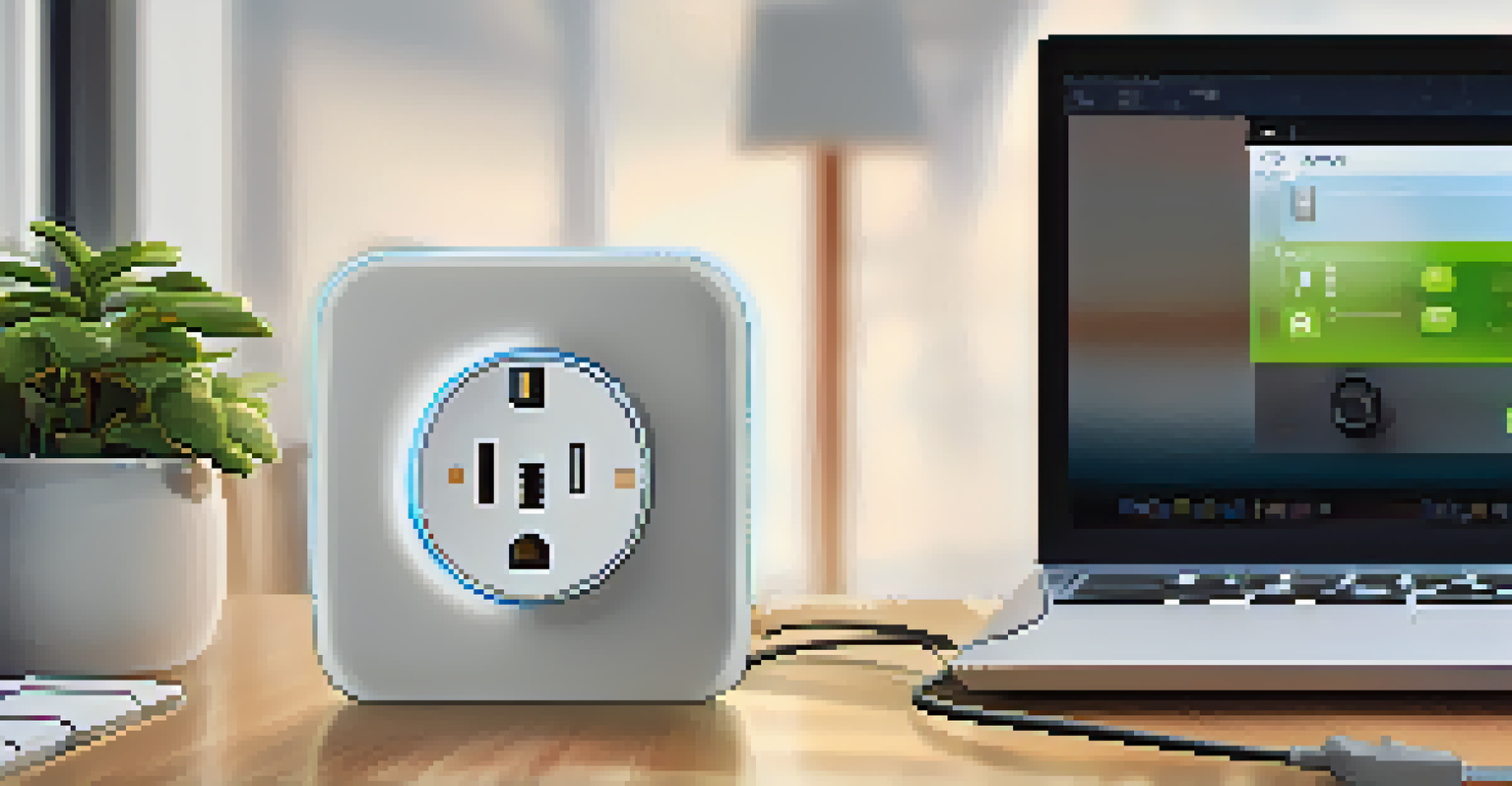Energy-Efficient Home Office: Automation Strategies

Understanding Energy Efficiency in Your Home Office
Energy efficiency is all about using less energy to perform the same tasks. In a home office, this means not only reducing your energy bills but also creating a more sustainable working environment. By integrating smart automation into your workspace, you can achieve significant energy savings without sacrificing comfort or productivity.
Energy efficiency is doing more with less.
Imagine your office lighting automatically adjusting based on the time of day or the amount of natural light streaming in. This not only ensures optimal lighting conditions for your work but also minimizes unnecessary energy use. Understanding these efficiencies is the first step toward creating an energy-efficient home office.
Additionally, energy efficiency contributes to a healthier planet. By making small changes in your home office setup, you can reduce your carbon footprint, which is a win-win for you and the environment.
Smart Lighting Solutions for Energy Savings
Switching to smart lighting is one of the easiest ways to enhance energy efficiency in your home office. Smart bulbs can be programmed to dim or turn off when you leave the room, ensuring you’re not wasting energy. Plus, they can be set to mimic natural daylight, which can help improve your mood and productivity.

For example, you might consider a smart lighting system that adjusts automatically as the day progresses. This not only saves energy but also helps reduce eye strain by providing the right amount of light when you need it most. Imagine working with a soft glow in the morning and a brighter light as the sun sets.
Enhance Energy Efficiency at Home
Implementing smart automation in your home office can significantly reduce energy consumption while maintaining comfort and productivity.
More importantly, smart lighting can be controlled via an app or voice command, making it incredibly convenient. This level of control can lead to significant energy savings and a more comfortable work environment.
Temperature Control with Smart Thermostats
Temperature can greatly affect your comfort and productivity levels in a home office. Smart thermostats allow you to automate heating and cooling based on your schedule, ensuring that your workspace is always at an ideal temperature when you need it. This means no more wasting energy heating an empty room.
The greatest threat to our planet is the belief that someone else will save it.
For instance, you could set your thermostat to lower the temperature during the hours you’re typically not working. Some smart thermostats even learn your habits over time, making automatic adjustments that ensure efficiency without you having to think about it.
By optimizing your home office’s temperature, you not only enhance your comfort but also reduce energy costs, making your workspace both efficient and enjoyable.
Utilizing Smart Plugs for Device Management
Smart plugs are an excellent tool for managing the energy consumption of your devices. By connecting your electronics to smart plugs, you can schedule them to turn off when you’re not using them. This simple action can help reduce standby power, which is often referred to as 'phantom load.'
Imagine you have a printer and a few chargers that could easily be forgotten about. With smart plugs, you can set them to turn off at a specific time each day, ensuring they aren’t draining energy unnecessarily. This not only helps lower your energy bill but also extends the lifespan of your devices.
Utilize Smart Devices for Control
Smart lighting, thermostats, and plugs allow for convenient management of energy usage, helping to save money and extend device lifespan.
Using smart plugs adds a layer of convenience and control to your home office, allowing you to manage multiple devices effortlessly while contributing to energy efficiency.
Integrating Energy-Efficient Appliances
When setting up your home office, consider investing in energy-efficient appliances. Devices such as printers, computers, and even coffee makers often come with energy ratings that indicate their efficiency. Choosing ENERGY STAR-rated products can help you save money over time while also being environmentally responsible.
For example, an energy-efficient printer not only uses less electricity but may also offer features that reduce paper waste. This can be a great asset for anyone looking to maintain an organized and eco-friendly workspace.
Ultimately, integrating these appliances into your home office can lead to significant energy savings while enhancing your overall work experience.
Smart Security Systems for Energy Management
A smart security system can contribute to energy efficiency by managing lighting and heating based on occupancy. For example, motion sensors can trigger lights to turn on when you enter your office and off when you leave, reducing energy waste. This automation ensures that your office remains well-lit only when needed.
Additionally, some smart systems can integrate with your thermostat, adjusting the temperature based on whether anyone is present. This means you won’t be heating or cooling an empty space, leading to further energy savings.
Regular Maintenance Ensures Efficiency
Consistent upkeep of appliances and smart devices is crucial for sustaining energy efficiency and avoiding unnecessary costs.
By utilizing a smart security system, you not only enhance the safety of your home office but also optimize energy use, making your workspace more efficient.
Regular Maintenance for Optimal Efficiency
To keep your energy-efficient home office running smoothly, regular maintenance is key. This includes cleaning dust from your smart devices, checking for firmware updates, and ensuring your appliances are functioning properly. Neglected appliances can lose efficiency over time, leading to unnecessarily high energy consumption.
For example, a clogged air filter in your heating system can cause it to work harder than necessary. Regularly changing filters and cleaning vents can help maintain efficiency and prolong the life of your systems.

By staying proactive with maintenance, you ensure that your energy-saving strategies remain effective, helping you stay comfortable while saving money.
Embracing the Future of Home Office Automation
The future of home offices is undoubtedly leaning toward increased automation and energy efficiency. With advancements in technology, the options available to create a smart home office are continuously growing. From voice-activated devices to AI-based systems that learn your preferences, the possibilities are exciting.
As you embrace these changes, think about how each automation strategy can contribute not just to your work-life balance but also to a more sustainable future. Every small step you take toward energy efficiency can have a larger impact over time.
By integrating these automation strategies into your home office, you'll not only improve your work environment but also play a part in creating a greener planet.